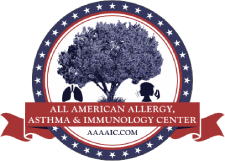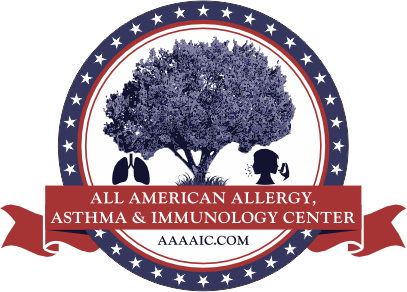Vaccine Reactions:
Background – The incidence of vaccine reactions is extremely rare as it is estimated to occur in 0.000002% or 2 per 1 million doses annually of the general population. Vaccine reactions are either Immediate or delayed. Immediate reactions usually occur within seconds up to an hour of receiving a vaccine. It can be due to direct or via IgE antibody activation of inflammatory cells (mast cells, basophils, eosinophils etc.). Delayed reactions occur usually after an hour of receiving a vaccine. It can be due to activation of several inflammatory pathways such as T cell or complement system. There are also mimickers of vaccine reactions such as vasovagal reaction (low blood pressure, pallor, sweating, weakness, nausea, vomiting, slow heart rate, and if severe, passing out) and anxiety related reaction (fast heart rate, globus sensation, nausea, diarrhea, vomiting, and tremors). The mimickers can happen immediately or be delayed. Patient history is a major part of differentiating the mechanism of action for vaccine reactions.
How it works/Pathophysiology – For immediate reactions, exposure to the vaccine that one is allergic to causes the immune system to produce an antibody (IgE). The IgE antibody in turns makes inflammatory cells that line the tissues in the body release inflammatory mediators such as Histamine and Leukotrienes. The same can also occur by direct activation of inflammatory cells by the vaccine. These inflammatory mediators can cause symptoms that adversely affect the airways, skin, gut and even the cardiovascular system. For delayed reactions, the inflammatory cascade is ignited through several pathways and causes similar symptoms but in a delayed fashion. The same organ systems can be affected.
Symptoms –
- Symptoms of a mild vaccine reaction may include:
- Itchy or runny nose, sneezing
- Itchy or tingling sensation in the mouth
- A few hives, mild itching of skin
- Mild nausea or discomfort
- More severe symptoms include:
- Hives over large area of the body
- Shortness of breath, wheezing, repetitive cough
- Swelling of tongue or lips
- Hoarse, tightness in throat, trouble breathing or swallowing
- Pale/blueish appearance, faint, dizzy
- Stomach discomfort such as abdominal cramps, diarrhea, vomiting
- Feeling of impending doom
The most severe vaccine allergic reaction is anaphylaxis which is a life-threatening whole-body reaction that can impair your breathing, cause a dramatic drop in your blood pressure, and affect your heart rate. Anaphylaxis can come on within minutes of exposure to the trigger vaccine and can be fatal if not treated promptly with an injection of epinephrine (adrenaline).
Diagnostic Testing – Vaccine or vaccine component Skin testing consist of Prick or Intradermal Skin testing consist of pricking or intradermally introducing the arms and/or back with a diluted dose of the vaccine in question or component(s) of the vaccine (stabilizer, excipient, or preservative; see list below). 20 minutes later, the wheel and flare of the prick site is measured, and the allergy provider will discuss the results and overall interpretation.
In -Vitro Vaccine component skin testing consists of whole blood draw at a local lab for which the whole blood is analyzed for the IgE antibody to component(s) of the vaccine (stabilizer, excipient, or preservative; see list below). About 1.5 wks later, the allergy provider will discuss the results and overall interpretation.
Patch Skin Testing consists of directly exposing a patient’s skin to a suspected component of the vaccine (stabilizer, excipient, or preservative; see list below). Very small chambers containing different potential allergens are taped to a patient’s back for several days to see what skin reactions occur. Chambers may contain a variety of substances to include vaccine stabilizers, adjuvants and preservatives. Localized patches of inflammation appear within 2 to 4 days, or even up to a week, if a skin allergy is present.
Vaccine Challenge Testing consists administration of the vaccine in question under clinical supervision. It is usually done in a stepwise fashion over increments of time (i.e 10% then 30min later the remaining 90%; 10/90 challenge). It can be open or blinded (patient receives a fake vaccine and the real one but only the allergy team knows the identity of each injection). Then the patient is observed for at least 1 hr. This test is the most accurate diagnostic testing for vaccine allergies. The test is conducted under physician supervision. The allergy provider will determine the patient’s candidacy.
Therapies:
Avoidance – All patients with a confirmed vaccine reaction should practice strict avoidance of the vaccine or the component of the vaccine that triggered the reaction. Your allergy provider will provide a comprehensive list of other vaccines or products that contain any of the components that you may have sensitivity to.
Egg Allergy and flu vaccine – Egg allergic patients can receive an influenza vaccine without any additional precautions beyond those recommended for any vaccine. The rate of a reaction to flu vaccine in egg allergic individuals is no greater than in non-egg allergic individuals. However, patients can request testing and or challenge of a flu vaccine in question.
COVID Vaccine – PEG (polyethylene glycol) is speculated to be a potential culprit in some allergic
reactions to SARS-CoV-2 mRNA vaccines. PEG and polysorbate are found in many health and beauty products and in foods (salad dressings, dried soups, mixes for cakes, muffins, and seasoning blends) and beverages (alcohol, sodas and flavored teas), and are routinely used and tolerated in daily life. The data on COVID vaccines is limited. However, allergic reactions may be more likely with higher molecular weight agents like PEG. PEG is also cross reactive with polysorbates. There is testing for PEG available and COVID vaccine. COVID Vaccine testing and challenges are also available. Your allergy provider will determine candidacy for any testing or challenge.
Vaccine Adjuvants, Excipients and Preservatives are components of the vaccine that keep the vaccine stable, free of infectious pathogens, and preserve its efficacy. If a vaccine reaction is suspected, it is important for you to provide the vaccine brand name, dosage, series, and lot number to the allergy provider. Some of the vaccine components include:
- Thimerosal is a preservative used in multi-dose vials of flu vaccines to prevent contamination with bacteria or fungus, which could be deadly. Thimerosal is made from a type of mercury call ethylmercury. This kind of mercury is broken down by the body and clears out of the blood quickly. Ethylmercury is very different than methylmercury. Even though there was no evidence that thimerosal in vaccines was dangerous, in 2001, it was removed from vaccines in the U.S. in an effort to reduce overall mercury exposure among infants. To keep vaccines safe from contamination without the use of thimerosal or other preservatives, they were either reformulated or put into single-dose vials. Now, the only vaccines in the U.S. that use thimerosal as a preservative are flu vaccines in multi-dose vials. (Thimerosal-free, single-dose vials of flu vaccine are also available in the U.S.)
- Formaldehyde is a colorless gas that is a byproduct of metabolism so it is already present in the human body. People also encounter formaldehyde every day in the environment. It is used in making building materials and many household products, and formaldehyde also gets into the air through car tailpipe emissions. Formaldehyde is used is used to inactivate bacterial products for toxoid vaccines (DTaP and Tdap), and to kill unwanted viruses and bacteria that might contaminate the vaccine during the manufacturing process. Most formaldehyde is removed from the vaccine before it is packaged.
- Aluminum is commonly found in food, health-and food-related products, water, infant formula and even breast milk. And for over 75 years, very small amounts of aluminum (aluminum gels or aluminum salts) have been added to some vaccines as “adjuvants” to help boost the body’s immune response. Without the use of these aluminum gels/salts in these vaccines, healthcare providers would need to give more doses of the vaccine or there there would be less immunity provided by the vaccine, and therefore less protection from the disease. Aluminum is contained in Hepatitis A, B, DTAP, H.Influenza type B, and Pneumococcal Vaccines.
- Egg Protein is vaccines, like MMR (measles, mumps, and rubella) and some flu vaccines, are created in eggs, which means that some egg proteins are present in the final vaccine product. The egg proteins help manufacturers to grow enough of the virus or bacteria needed to make the vaccine. Egg containing vaccines can be safely given to all patients with egg allergies, including patients with a history of severe allergic reactions to eggs.
- Gelatin protects vaccines them against freeze-drying or heat during the transportation and storage process. Some gelatins contain pork or beef products. It is contained in Nasal Flu vaccine (Fluenz), MMR (VaxPro), Zostavax, and Varicella vaccine (Varivax and Varilrix). People with severe allergies to gelatin, pork or beef should talk to their allergy provider before getting vaccinated.
- Monophosphoryl lipid A was isolated from the surface of bacteria. It is modified so that it is not harmful when added to vaccines. The only vaccine in the U.S. that currently uses this adjuvant is the shingles vaccine called Shingrix®.
- QS21 was Isolated from the bark of Quillaja saponaria trees, this molecule is soap-based. It is only found in the shingles vaccine called Shingrix.
- Neomycin is an aminoglycoside antibiotic that is contained in Measles, mumps, rubella (MMR®), varicella (ProQuad, Varivax), Rabies vaccination (Imovax, RabAvert), some Influenza Vaccines, Polio (IPOL), Diphtheria, Tetanus, Pertussis, Polio (Kinrix®, Pentacel®, Quadracel®and Pediarix®), Hepatitis A (Havrix®, Vaqta® and Twinrix), Hepatitis B (Twinrix®).
- Kanamycin is an aminoglycoside antibiotic that is contained in Meningococcal B Vaccine (Bexsero®), and some Influenza Vaccines.
- Amphotericin B is an antifungal medication that is contained in Rabies (RabAvert®).
- Polymyxin B is a polymyxin antibiotic found in some Influenza Vaccines, Polio (IPOL), Diphtheria, Tetanus, Pertussis, and Polio (Kinrix®, Pentacel®, Quadracel and Pediarix®).
- Chlortetracycline is a tetracycline antibiotic found in Rabies vaccine (RabAvert)
- Gentamicin is an aminoglycoside antibiotic that is contained in some Influenza Vaccines.
Streptomycin is an aminoglycoside antibiotic that is contained in Polio vaccines (IPOL).

